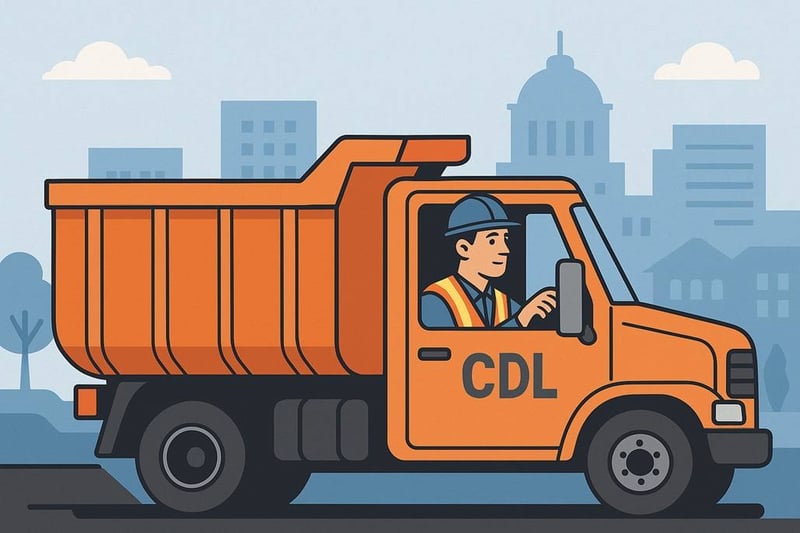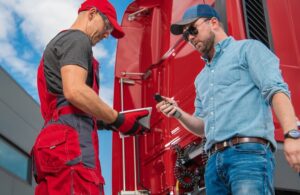Training Government Employees for CDL Roles
This guide is written for municipal government agencies, including HR departments, fleet supervisors, and public works and transit directors who are seeking solutions to Commercial Driver License (CDL) driver shortages. It explains how to implement an in-house CDL training program for government fleets using Driving-Tests.org’s CDL Premium online training platform. This FMCSA-approved, ELDT-compliant theory training program provides tools for municipalities to train existing employees to become fully licensed commercial drivers in as little as 2–4 weeks (compared with the typical average 6–12 week timeline). As a significant advantage, the Premium program gives applicants the ability to train without interrupting their city service responsibilities.
Background
U.S. municipalities are struggling with CDL driver shortages, especially in transit systems and public works departments. FMCSA’s ELDT regulations, made mandatory in 2022, worsened this situation due to the more stringent theory requirements and training necessary. The shortage of drivers can create a significant interruption in bus route coverage, garbage pickup, and snow removal.
Pain Points:
- Workforce Gaps: City services are interrupted by CDL driver shortages.
- Service Disruption: Long training timelines create staffing issues and delays.
- Compliance Complexity: FMCSA’s ELDT rules require specific topics and procedure coverage, including compliant reporting needs.
Best Practices for Transit Agency CDL Training Programs
Transit agencies (such as city bus services and county transit authorities) have unique passenger-focused CDL training needs. Nearly all transit drivers require a Class B CDL with a Passenger (P) endorsement, plus a School Bus (S) endorsement for school bus or shuttle services. The following best practices are recommended for a transit agency CDL training program:
- Passenger Safety and Endorsements: The training curriculum should cover all passenger endorsement knowledge and safety measures. It should include securement of wheelchairs and mobility devices, handling of emergency evacuations, and safe passenger loading and unloading.
- Alignment with FMCSA and State Requirements: The training content should meet federal and state CDL regulations. The Driving-Tests.org Premium Program is an FMCSA-approved ELDT theory provider that guarantees federal compliance and tailors practice questions to each state’s DMV exam.
- Flexible Scheduling to Maintain Service: A recent study by the American Public Transportation Association (APTA) noted that a shortage of transit operators is forcing agencies to reduce service in many cities. Flexible online learning options help to avoid this. Driving-tests.org’s online CDL curriculum allows trainees to study during off-hours or lighter shifts and rapidly achieve licensure.
- Use Qualified Instructors and Mentors: Combined with our Premium e-learning program, transit agencies should have experienced transit trainers or senior drivers mentor the trainees on items like route-specific skills needed.
- Track Progress and Ensure Exam Readiness: Monitor each trainee’s learning progress with our software’s administrative dashboard, which provides progress metrics and practice exam results. Supervisors can see practice test scores and know when someone is ready for the official knowledge exam.
Best Practices for Public Works Driver CDL Prep
Public works departments manage city and county fleets for services like street maintenance, sanitation, utilities, and snow removal. These operations rely on CDL drivers to run dump trucks, garbage trucks, bucket trucks, snow plows, and more. Training needs center on heavy vehicle operation and safety in service environments (streets, work zones), rather than passenger transport. A strong municipal driver training program for public works should address the following:
- Identify Required Licenses and Endorsements: Determine which CDL class and endorsements each job requires. Many public works drivers need a Class B CDL for single vehicles over 26,001 pounds (dump trucks or plows). Some roles might require a Class A (for combination vehicles or tractor-trailers) CDL or a Tank endorsement (water tank trucks for street cleaning or sewer flushing). Your training curriculum should be tailored to cover the exact exams your employees must pass: Class A or B general knowledge, plus any additional qualifications like air brakes, tank vehicle, or HazMat, if applicable. Our Premium online prep course includes all endorsement modules that a public works driver may need.
- Recruit Existing Employees (Mechanics, Laborers): Promote from within. Mechanics, equipment operators, or laborers are ideal candidates to become CDL drivers because they already understand the vehicles and local operations. Offering CDL training within the organization can fill driver vacancies faster.
- Minimize Service Disruptions with Flexible Training: Public works services (trash pickup, snow clearing, etc.) are vital to each area, so pulling employees away for off-site training can cause coverage issues. To avoid this, our training can be done on-site or online.
- Ensure Compliance and Transparency: Public works departments must follow federal and state CDL regulations. Our training program is fully ELDT-compliant and documented, automatically tracks completion of required theory topics, and submits ELDT completion certificates to the FMCSA’s Training Provider Registry (TPR) in real time.
Solution: Driving-Tests.org CDL Premium Online Training
Government agencies can install our flexible, in-house CDL Premium platform to foster quick, cost-effective, ELDT-compliant training.
Platform Benefits:
- Self-paced, online learning, available on any online device.
- FMCSA-certified ELDT curriculum for Class A and B, Air Brakes, and endorsements like Passenger (P), School Bus (S), and Tank.
- State-specific CDL knowledge test preparation.
- An administrative tracking dashboard that works in real time.
- Automated reporting to the FMCSA Training Provider Registry (TPR).
How to Implement Your In-House Training Program:
- Identify Internal Candidates: Recruit current municipal employees (mechanics, utility workers, sanitation crew members, or administrative staff).
- Provide Immediate Online Access: Enroll trainees in Driving-Tests.org’s CDL Premium program to begin the FMCSA-compliant theory portion of their training.
- Coordinate with Department Operations: Allow candidates to complete coursework during downtime.
- Use Experienced Personnel as Mentors: Pair learners with experienced CDL operators.
- Schedule Exams Early: As soon as a trainee completes their online modules and scores consistently well on practice tests, assist them in scheduling the DMV knowledge exam.
- Track ELDT Compliance Automatically: Use the platform’s dashboard to monitor progress and automatically submit to the FMCSA TPR once complete.
Results
Agencies using Driving-Tests.org’s CDL Premium training have experienced:
- 95% or higher first-time pass rates on CDL permit tests.
- CDL onboarding timelines reduced to 2–4 weeks, instead of the usual 6–12 weeks.
- Zero disruption to municipal services.
- In-house promotions into CDL positions.
Success story
In early 2024, the City of Danville, Virginia faced a severe shortage of CDL-qualified drivers across its Public Works and Transit Divisions. Snowplow coverage during winter storms had been drastically impacted by driver shortages, and sanitation schedules were at risk due to a lack of licensed staff. Hiring additional commercial drivers proved difficult as local CDL schools had months-long waiting lists, and qualified drivers were being recruited away from the area by private-sector employers offering sign-on bonuses.
Danville’s Public Works Director, Mark Raines, implemented Driving-Tests.org’s CDL Premium program.
Implementation
- Participants: Six employees were selected (four sanitation workers and two mechanics).
- Training Delivery: The employees were enrolled in the online CDL Premium platform.
- Schedule: Trainees studied during downtime, averaging 1–2 hours of study per day.
- Mentorship: Each trainee was paired with an experienced driver from the department.
Results
- Time to CLP: All six trainees passed the DMV permit exam on their first attempt within three weeks.
- ELDT Compliance: The online platform automatically submitted all ELDT training completions to the FMCSA Training Provider Registry.
- Service Continuity: No city routes or services were delayed or canceled during the training period.
- Promotion Pipeline: Four of the six employees received internal promotions into full-time driver roles.
- Cost Savings: The city saved over $25,000 compared to third-party CDL school tuition, not including saved labor and overtime costs from covering vacant driver shifts.
Key Takeaways
Driving-Tests.org’s CDL Premium platform enables municipalities to:
- Establish self-contained CDL driver pipelines.
- Train staff flexibly without compromising city services.
- Ensure full FMCSA ELDT compliance.
- Quickly scale up transit and public works driver capacity.
How Driving-Tests.org Can Help You
- Mobile, Flexible, Self-Paced: Accessible from home or school, it accommodates varied schedules.
- Administrator Oversight: See exactly how each trainee is progressing.
- High Retention, Fast Results: Online preparation helps learners pass tests confidently and start routes sooner.
- Support for Community-Based Recruitment: Help aides and locals upskill into licensed drivers.
By leveraging this model, municipalities not only meet compliance requirements but also build a sustainable pipeline of drivers from within.
Incorporating this platform into your training is beneficial to learners and especially helpful in creating a well-rounded training approach for your employees. It also provides these advantageous features:
- Comprehensive CDL Test Preparation: Access to up-to-date practice tests and study materials aligned with FMCSA guidelines.
- Progress Tracking and Reporting: Easily track each driver’s progress and test results to streamline record-keeping.
- Multi-User Management: Add and remove drivers or training coordinators quickly; keep everyone accountable with assigned modules.
- Engaging Mobile-Friendly Content: Drivers can study on their own schedule, reducing classroom time and improving pass rates.
References
American Public Transportation Association. (2023). Transit workforce shortage study: Findings and recommendations.
Driving-Tests.org. (2024). Corporate CDL Premium Training Platform Overview.
Federal Motor Carrier Safety Administration. (2022). Entry-Level Driver Training (ELDT) regulations. U.S. Department of Transportation.
Infinity Workforce. (2024, October 21). Guide to new ELDT requirements.
National Association of Counties. (2023). CDL driver shortages and local government operations.
School Transportation News. (2023). ELDT mandate impacts school district CDL compliance and bus driver onboarding.
Trucking Dive. (2022, February 11). FMCSA launches new driver training rule to improve road safety.



